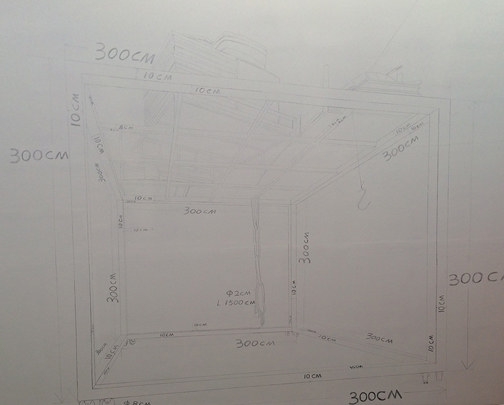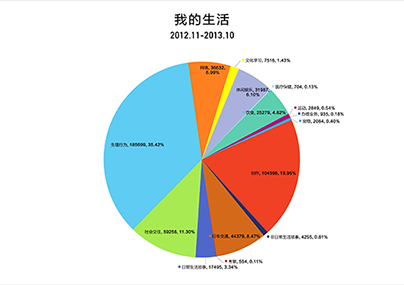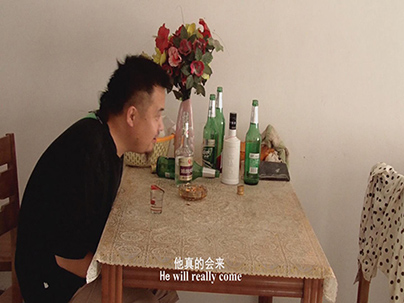“Unlived by What is Seen”: group exhibition curated by Sun Yuan + Peng Yu and Cui Cancan
Pace Gallery Beijing, Tang Contemporary Art Center, Galleria Continua (798 Art District, No. 2 Jiuxianqiao Road, Chaoyang District, Beijing), Dec 13, 2014—Mar 15, 2015
As the Chinese title of the exhibition (literally “No Action in the Image”) suggests, there is no need for much “action” on the audience’s part when it comes to these “images”. One hurried glance over everything and the viewer can leave with a sufficient sense of what is going on. Features expected of an exhibition—“originality,” “materiality,” “theater,” “space”—find little correspondence here. Browsing on a computer screen is good enough to convey a sense of the live version. “Unlived by What is Seen” is a repeated curatorial collaboration between the artists Sun Yuan & Peng Yu and the curator Cui Cancan. Similar to “Reversing Modificaton,” the event they organized together with Zhao Bandi at Tang Contemporary Art Center in December 2013, this is an unconventional exhibition held in a conventional exhibition venue.
“Unlived by What is Seen” takes place simultaneously across 798 Art District’s three heavyweight galleries: Pace Beijing, Tang Contemporary Art Center, and Galleria Continua. This is no small-scale exhibition, and yet the content with which it concerns itself is fairly—shall we say—“one-dimensional.” There are almost no completed art works; instead, the thirty-odd artists (artists who, selected by all three curators, span a wide spectrum of age and degree of renown) provide photographs and film clips of themselves at work and objects left over as evidence of past creative processes. For instance: He Chi’s imitation of the rural existence of his father’s generation in his video “So Forget” (started in 2014), the QR code for the Taobao shop Jiang Bo opened with his brother-in-law (in the work titled “Persuading My Brother-in-Law to Switch Careers”), Li Binyuan’s screenshot of his WeChat “Moments,” (“2013131-2014927”), the ring Ma Yujiang made for his girlfriend out of an apricot core (“Core•Ring”), a photograph of Zhao Bandi holding a stuffed panda and shaking hands with an urban sanitation worker (“Zhao Bandi’s Panda Career”), and so on. Each artist presents a snippet of personal experience; this critic has not the will to dwell on the details, settling instead on the conclusion that this is a matter of “everyone having his or her own story.” The videos on display and documentations of creative work are of the type that might usually serve as supplementary materials in exhibitions. But here, they are at center stage. To be sure, as with so many so-called “dematerialized” (quwuzhihua) exhibitions, academic forums held by art galleries, and other lofty art events, the emphasis for this exhibition when it comes to the galleries seems to be on keeping up the appearance of the academic and experimental. However, upon more careful reflection, even if it is all a gimmick, the exhibition’s self-reflexive spirit is of important note.

厉槟源,《2013131-2014927》



何迟,《就这样忘记》,双屏影像,时长不定 2014年始

A History of “Anti-Image”
To be equipped to interpret the cultural message presented by this exhibition, and to begin to understand why a curatorial concept would concern itself with the “image” at all, we need to start with the fundamental precept of “Art ≠ Image.” What, precisely, is the problem with “images”? For a very long period of time, the relationship between visual art and images was not in dispute. The image was both the means and the end. But then, at a certain point in time, artists became suspicious of the trusty “image.” In brief: not counting the iconoclastic movements of the Middle Ages, since the onset of modernity artists’ reflections upon or revolts against images occurred in three major waves. The first wave accompanied the invention of the camera in the early nineteenth century, which produced unprecedented anxiety in artists as they suddenly realized they had lost their monopoly on images. Playing with machine-made images became an entirely new artistic proposition. The second wave came with the emergence of the anti-figurative aesthetic in response to the abstraction of the early twentieth century. For a time, the abstract was the visual epitomization of cultural advancement; the formalist critic Clement Greenberg issued a clarion call to this end in his famous 1939 essay “Avant Garde and Kitsch”, offering a criterion for the trend: “In Repin’s picture the peasant recognizes and sees things in the way in which he recognizes and sees things outside of pictures—there is no discontinuity between art and life…Ultimately, it can be said that the cultivated spectator derives the same values from Picasso that the peasant gets from Repin.” If the abandonment of recognizable images and the return to the medium of art is the avant-garde’s dissective attempt to preserve its elite status, then the large-scale movement of art into society, in the context of the social movements of the sixties and seventies—or perhaps art’s transformation into a social practice—constituted a complete and thorough farewell to images. And this is a trend that is still unfolding (is it not?).
The Image Paradox
In this way, the anti-figurative impulse quietly evolved into anti-image; that is to say that there have already been at least thirty to forty years of history during which artists have considered their own behavior to be artistic practice itself. Methods of “de-imagization” (qutuxiang)and similarly “de-materialization” (quwuhua) are thus in no way new propositions for contemporary art. But the question of whether images could serve as art’s last line of defense has already been reduced to a question of semantics, since the more times the last line is crossed, the closer “art” comes to having truly forsaken its formerly given referent, leaving it no choice but to vie with other fields. To truly exit images, art would need a boldness and audacity of vision. Especially with current “cutting edge” Chinese artists, it seems they stand perplexed at a very tangled intersection: first, there is the stalwart “traditional” route, but the moment you set foot on that it becomes a “path of no return” and your “cutting-edge” guarantee is automatically broken. Second, there is the “Pop” art shortcut, but for Chinese artists, the impact of “Political Pop” was already synonymous with the fastest way downhill before the form had even reached the peak of its proliferation; with Pop, it is difficult to fashion the quality of the vanguard. That is all to say that it is easy for the approach of “using images to reflect upon images” to devolve once again into a mere symbol within the political or commercial landscape—just as cutting edge feminist art reduces itself, to a degree, through a reputation for an anti-male perspective.
Chinese contemporary artists are perplexed in the face of this image problem. Countless experiments have already run their course, and every likeness that could have possibly been appropriated has already been appropriated. Artists’ most urgent priority is finding a way to break into new territory. The reflexive use of images was once the stamp of elitism for avant-garde artists. Now, this seemingly fearless attack—in its martyring spirit—exacted on the “image” and the materialization they represent takes place in the name of “individual experience” but in reality comes out of the exact same impulse: in a field whose identity is so intimately linked to images, the choice to leave images in the dust is about maintaining a necessary degree of mystique and superiority. Thanks to the deification of our modernist predecessors, “individual experience” now too can walk tall with the confident glow of the “cutting edge.” But this is the true paradox of the “anti-image” wave: it seems the fearless spirit of self-sacrifice has in fact been exchanged for the exhibition of insignificant everyday experience. This writer does not doubt that the artists understand the significance of images, but this means that they also know the significance of throwing them away. What does this imply? The statement made in the exhibition title, that the “action” is not in the image, is justified, as images in contemporary art have almost purely become strategies for acquisition, trailing dutifully at the heels of profit. But if artists truly bid farewell to images, where do they go next? Duchamp could turn to chess and Beuys to planting trees, but this was because they had already fulfilled an important precondition: they were visionaries in a hero-worshipping age.
Experience as Image Substitute?
The biggest problem with this exhibition is that the majority of its participating artists have not exhibited much thought or originality, instead slickly substituting the personal for intelligence. It cannot be denied that in an era dominated by collective thinking, emphasis on individuality is of great value. It could even be said that the ways in which members of this “New Generation” (Xinshengdai) (of which Liu Xiaodong is a chief representative) reproduce their own life experiences as contemporary art have opened up a new chapter. But then, kowtowing to the market, the reproduction of individual experience, too, has become instrumentalist, in spite of its idyllic, bottom-of-my-heart “sincerity.”
At its foundations, being “anti-image” is the logic inherent in modernist elitism. But in relation to art currently in China, there is a vital need to more deeply consider the relationship between image and art. Sandwiched between conservative traditional themes and over-simplified political symbolism, artists here who hold independence in high esteem have only one option, it seems, and that is to return to individual experience. But just as there is a story behind every winner, experience, like images, can fall just as easily into the quagmire of stereotypes; the latter is just by far easier to spot. We need to be careful and aware of the fact that the groupthink of the old days is not necessarily so distant and bygone among members of the younger generation. Groupthink tends to descend often upon times marked by the pursuit of individuality. When fashionably dressed young men and women seek out distinction, it is even harder to escape the fate of convergence. The more people seek personalization, the more their outfits clash and the greater the chance of their collision—since folks all want to head there en masse. Artists are the same; if an artist loses his reflectiveness and thought, if all he has for the material of his practice is his own unique life experience, he is the most likely to fall prey to the most insidious kind of collectivism. Since we now live in a world dictated by the forces of standardization and homogenization, these forces work on our everyday thought processes in more subtle ways than ever.
In the end, individuality, like the image, is no panacea; we can see by observing the activities of these artists, all unrelated to each other, that in the absence of criticism, and in an age that is, on the surface, a diverse one, art can end up relying on only experience, rather than on thought. If this is the case, the solution does not lie so much in the art itself as it does in the need for the continued critique of everyday life along the lines of Lefebvre. If individual experience can replace thought, the challenge transcends history, and then this will only become a confused period of history in terms of records and documentation.
Doing over Saying
It is hard to say whether or not this exhibition has opened up a new approach to art, but in its behavior it at least can be considered a meaningful moment. “Unlived by What is Seen” captures the crux of the problem of contemporary art’s over-saturation with images. True, it may make things worse by over-correcting, targeting “images” in its unearthing of the implicit conflict. But it is nonetheless a necessary step, in that the conflict emerges at all. The exhibition illustrates that a portion of artists and curators in China already have a hazy awareness of the elitist bent the “anti-image” wave is capable of transmitting. But this awareness is not necessarily of a kind that comes about consciously, just as China’s art and literary youth in the eighties and nineties had a “cultural revolutionary” style to their introspective impulses, moving towards the extremes of action and spiritual interrogation at the same time as they did to the extremes of materiality. Do artists’ personal experiences truly qualify as artistic practices in and of themselves? Without real reflection, perhaps those most faithful to their immediate experiences will become the best imitators. Obviously, this exhibition’s true focus is not on a departure from images but rather on the manifestation of an elite temperament; for instance, in the exhibition there are several works that, contrary to the exhibition title, not only possess “action” in their images, but also very much need to emphasize the importance of the image itself. The photograph of Zhao Zhao stabbing Sun Yuan in the back with a knife, for example, (“Slap, Affair, Leather Shoes, and Home”) operates according to what is in fact a slightly dated confrontational logic. Nevertheless, for the exhibition, the work is replete with symbolism: an artist takes a knife to another artist, just as art would like to do to the image. If rebellion is the duty of the avant-garde (as has been assumed since Courbet), then at a time when we are struggling to find out what exactly we should be rebelling against, the “image”—the very product of art—becomes the object of such a function. Is this then a cycle intrinsic to the system of art?
This exhibition brings with it a positive kind of closure: in a nebulous stage stuck between experience and expression, the repudiation of images is without a doubt an instance of art reinventing its own wonderfully clever tactics of stalling. When you cannot find something to express, using experience in the place of expression is your best option. The image is art’s protective veil of legitimacy, but it can also be its shackles.
To be anti-image is to be against co-option. It is, in the end, still a continuation of a nexus of avant-garde ideals.

